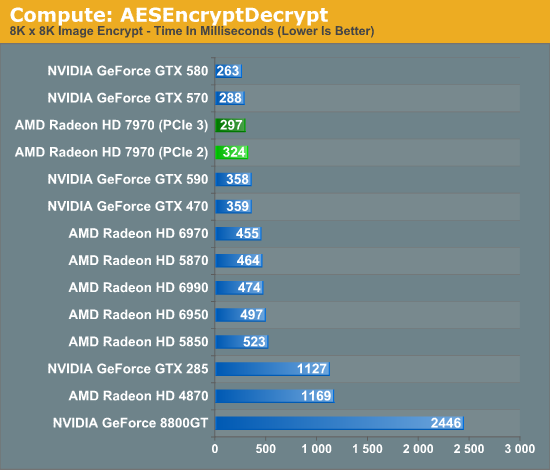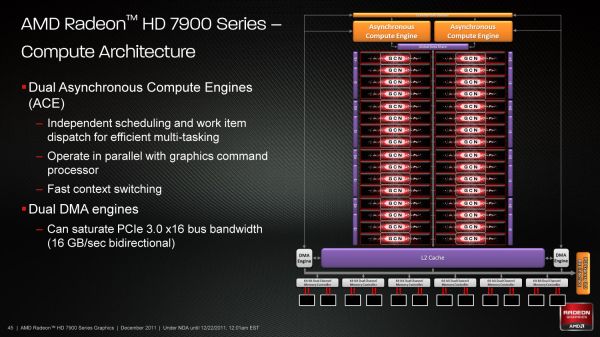AMD Radeon HD 7970 Review: 28nm And Graphics Core Next, Together As One
by Ryan Smith on December 22, 2011 12:00 AM EST- Posted in
- GPUs
- AMD
- Radeon
- ATI
- Radeon HD 7000
PCI Express 3.0: More Bandwidth For Compute
It may seem like it’s still fairly new, but PCI Express 2 is actually a relatively old addition to motherboards and video cards. AMD first added support for it with the Radeon HD 3870 back in 2008 so it’s been nearly 4 years since video cards made the jump. At the same time PCI Express 3.0 has been in the works for some time now and although it hasn’t been 4 years it feels like it has been much longer. PCIe 3.0 motherboards only finally became available last month with the launch of the Sandy Bridge-E platform and now the first PCIe 3.0 video cards are becoming available with Tahiti.
But at first glance it may not seem like PCIe 3.0 is all that important. Additional PCIe bandwidth has proven to be generally unnecessary when it comes to gaming, as single-GPU cards typically only benefit by a couple percent (if at all) when moving from PCIe 2.1 x8 to x16. There will of course come a time where games need more PCIe bandwidth, but right now PCIe 2.1 x16 (8GB/sec) handles the task with room to spare.
So why is PCIe 3.0 important then? It’s not the games, it’s the computing. GPUs have a great deal of internal memory bandwidth (264GB/sec; more with cache) but shuffling data between the GPU and the CPU is a high latency, heavily bottlenecked process that tops out at 8GB/sec under PCIe 2.1. And since GPUs are still specialized devices that excel at parallel code execution, a lot of workloads exist that will need to constantly move data between the GPU and the CPU to maximize parallel and serial code execution. As it stands today GPUs are really only best suited for workloads that involve sending work to the GPU and keeping it there; heterogeneous computing is a luxury there isn’t bandwidth for.
The long term solution of course is to bring the CPU and the GPU together, which is what Fusion does. CPU/GPU bandwidth just in Llano is over 20GB/sec, and latency is greatly reduced due to the CPU and GPU being on the same die. But this doesn’t preclude the fact that AMD also wants to bring some of these same benefits to discrete GPUs, which is where PCI e 3.0 comes in.
With PCIe 3.0 transport bandwidth is again being doubled, from 500MB/sec per lane bidirectional to 1GB/sec per lane bidirectional, which for an x16 device means doubling the available bandwidth from 8GB/sec to 16GB/sec. This is accomplished by increasing the frequency of the underlying bus itself from 5 GT/sec to 8 GT/sec, while decreasing overhead from 20% (8b/10b encoding) to 1% through the use of a highly efficient 128b/130b encoding scheme. Meanwhile latency doesn’t change – it’s largely a product of physics and physical distances – but merely doubling the bandwidth can greatly improve performance for bandwidth-hungry compute applications.
As with any other specialized change like this the benefit is going to heavily depend on the application being used, however AMD is confident that there are applications that will completely saturate PCIe 3.0 (and thensome), and it’s easy to imagine why.
Even among our limited selection compute benchmarks we found something that directly benefitted from PCIe 3.0. AESEncryptDecrypt, a sample application from AMD’s APP SDK, demonstrates AES encryption performance by running it on square image files. Throwing it a large 8K x 8K image not only creates a lot of work for the GPU, but a lot of PCIe traffic too. In our case simply enabling PCIe 3.0 improved performance by 9%, from 324ms down to 297ms.

Ultimately having more bandwidth is not only going to improve compute performance for AMD, but will give the company a critical edge over NVIDIA for the time being. Kepler will no doubt ship with PCIe 3.0, but that’s months down the line. In the meantime users and organizations with high bandwidth compute workloads have Tahiti.











292 Comments
View All Comments
CeriseCogburn - Thursday, March 8, 2012 - link
Well, since you brought that up it reminded me of the PRAISE this or the 7870 article gave amd for "getting rid of all it's own competing cards" and zeroing their distribution so that there was only one choice and it wasn't competing with itself.I didn't hear a single Nvidia basher cry foul, that amd was playing with the market just to slam dunk some dollars on a new release...
I do wonder why when amd pulls the dirtiest of dirty, they are praised...
MrSpadge - Thursday, December 22, 2011 - link
They'd loose the entire market of Milkyway@Home crunchers if it was just 1/4.RussianSensation - Thursday, December 22, 2011 - link
FP32 = 3.79 TFlopsFP64 = 0.948 Tflops, which is about 40% faster than HD6970.
Ryan Smith - Thursday, December 22, 2011 - link
The keyword there was "up to". GCN actually supports 3 different FP64 configurations: 1/2, 1/4, and 1/16. 1/4 may be an artificial limitation on the 7970 or it may be the native speed Tahiti was designed for; it's not clear yet which of those is the case.WhoBeDaPlaya - Thursday, December 22, 2011 - link
Ryan, any chance you could try running a Bitcoin client on the card to see what kind of hash rates we'd get?Esbornia - Thursday, December 22, 2011 - link
Man this site is so biased against AMD it hurts, here we have a new architecture thats beats GTX580 in everything and sometimes GTX590 with almost half the power comsumption and they say the only thing 7970 does right is compute? That it is not a great product but only mediocre? Come on AnandTech we know intel owns you but this is getting ridiculous, see the other neutral sites reviews you will clearly see what AnandTech does if you are even a little smart.SlyNine - Thursday, December 22, 2011 - link
And a product that is 2 years removed from the 5870 and only performing about 40-60% better... and on a new 28nm chip to boot.It's just not that great.
RussianSensation - Thursday, December 22, 2011 - link
For almost $200 more as well....MrSpadge - Thursday, December 22, 2011 - link
Reading the entire review (apart from the conclusion) I came to the conclusion that GCN is really cool. Give it some more software support (=time), a cool BOINC project and the HD7950 and I may have found my next card. Can't say AT talked me off of it.MrS
WhoBeDaPlaya - Thursday, December 22, 2011 - link
WWYBYWB?